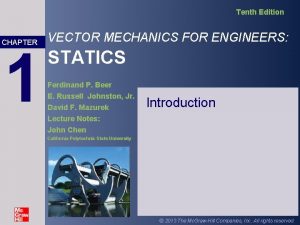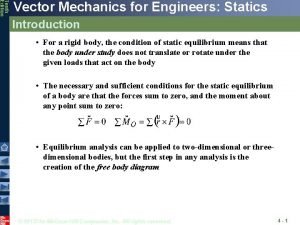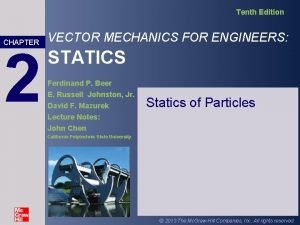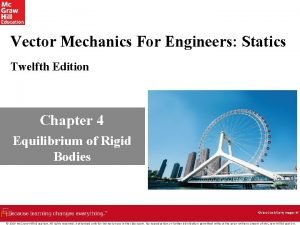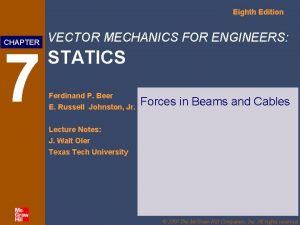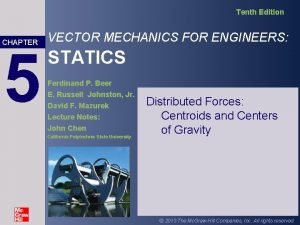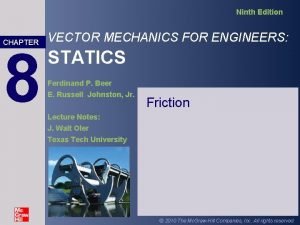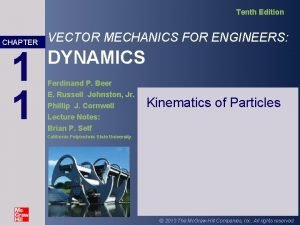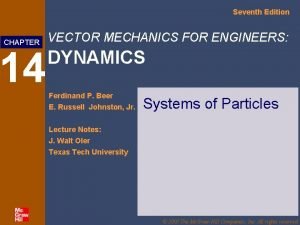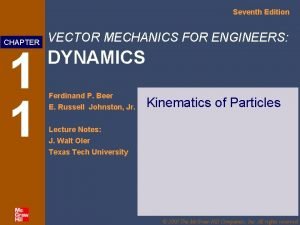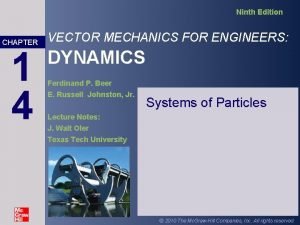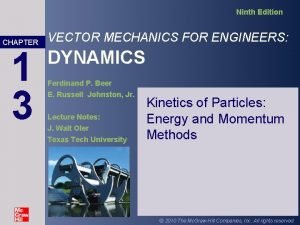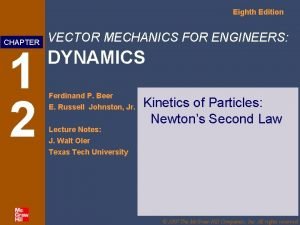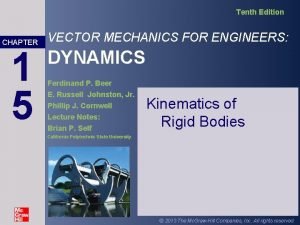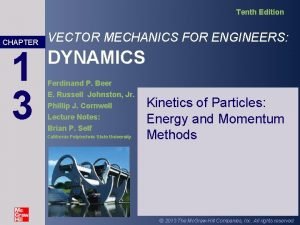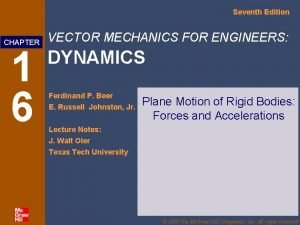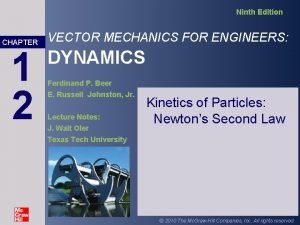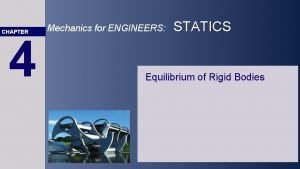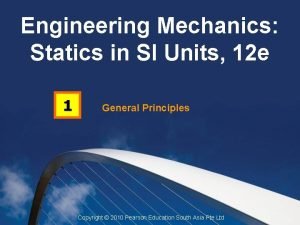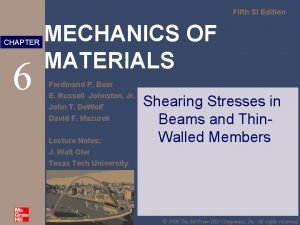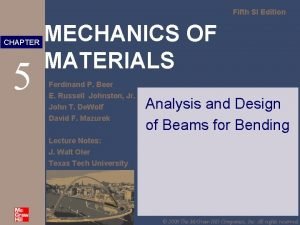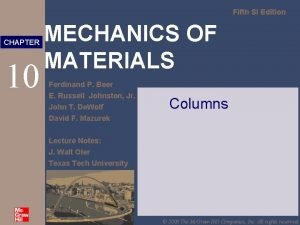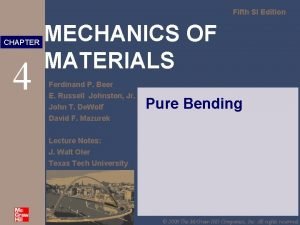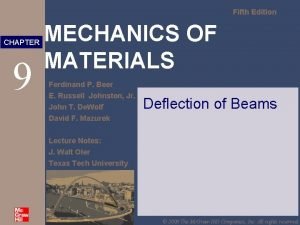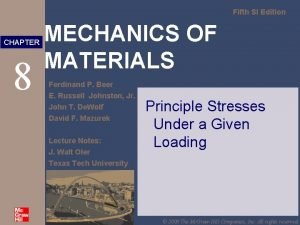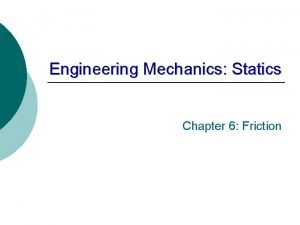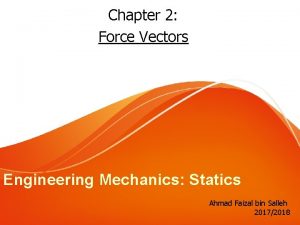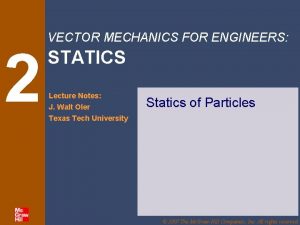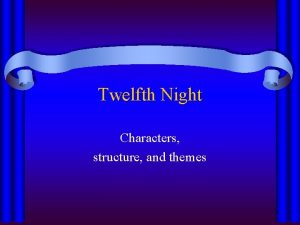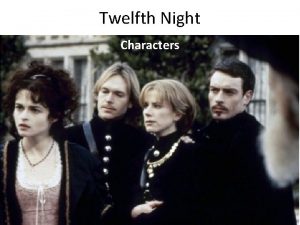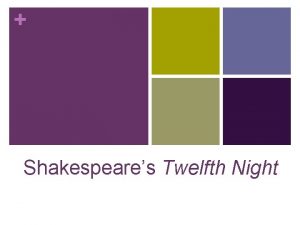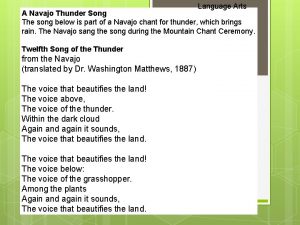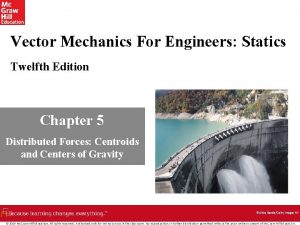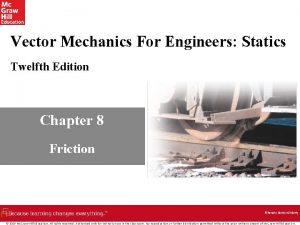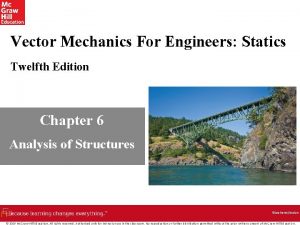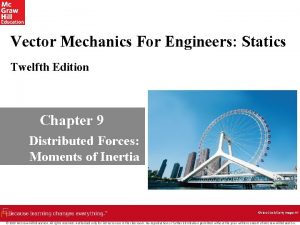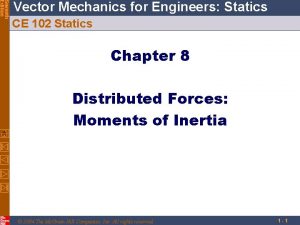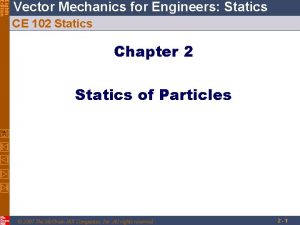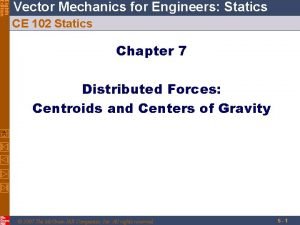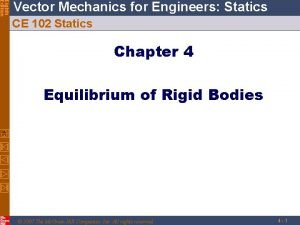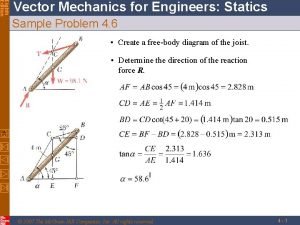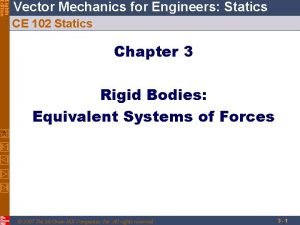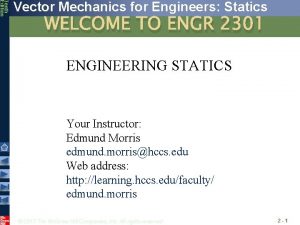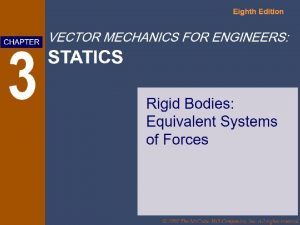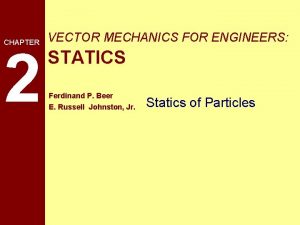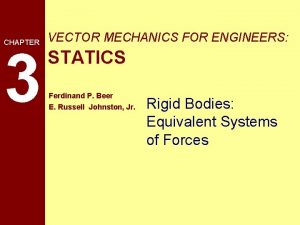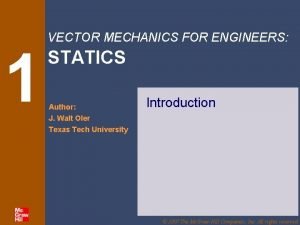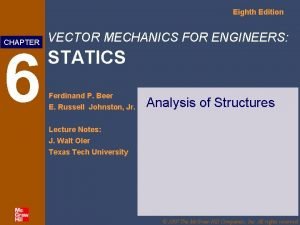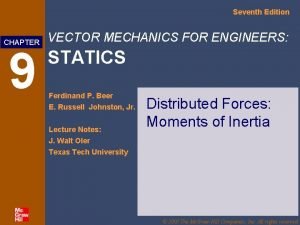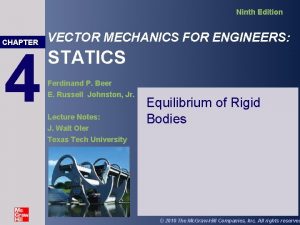Vector Mechanics For Engineers Statics Twelfth Edition Chapter














































- Slides: 46

Vector Mechanics For Engineers: Statics Twelfth Edition Chapter 7 Internal Forces and Moments ©Jonatan Martin/ Getty Images RF © 2019 Mc. Graw-Hill Education. All rights reserved. Authorized only for instructor use in the classroom. No reproduction or further distribution permitted without the prior written consent of Mc. Graw-Hill Education.

Contents Application Sample Problem 7. 4 Introduction Sample Problem 7. 6 Internal Forces in Members Cables With Concentrated Loads Sample Problem 7. 1 Cables With Distributed Loads Various Types of Loading and Support Parabolic Cable Shear and Bending Moment in a Beam Sample Problem 7. 8 Sample Problem 7. 2 Catenary Cables Sample Problem 7. 3 Relations Among Load, Shear, and Bending Moment © 2019 Mc. Graw-Hill Education.

Application Forces that are internal to the structural members – beams and cables – are the subject of this chapter © 2019 Mc. Graw-Hill Education. © Ross Chandler/ Getty Images RF

Introduction Preceding chapters dealt with: a) determining external forces acting on a structure and b) determining forces that hold together the various members of a structure. • The current chapter is concerned with determining the internal forces (i. e. , tension/compression, shear, and bending) that hold together the various parts of a given member. Focus is on two important types of engineering structures: a) Beams - usually long, straight, prismatic members designed to support transverse loads applied at various points along the member. b) Cables - flexible members capable of withstanding only tension, designed to support concentrated or distributed transverse loads. © 2019 Mc. Graw-Hill Education.

Internal Forces in Members • Straight two-force member AB is in equilibrium under application of F and −F. • Internal forces equivalent to F and −F are required for equilibrium of free-bodies AC and CB. • Multiforce member ABCD is in equilibrium under application of cable and member contact forces. • Internal forces equivalent to a forcecouple system are necessary for equilibrium of free-bodies JD and ABCJ. • An internal force-couple system is required for equilibrium of two-force members that are not straight. © 2019 Mc. Graw-Hill Education.

Sample Problem 7. 1 1 Strategy: • Compute reactions and forces at connections for each member. • Cut member ACF at J. The internal forces at J are represented by an equivalent force-couple system that is determined by considering equilibrium of either part. Determine the internal forces (a) in member ACF at point J and (b) in member BCD at K. • Cut member BCD at K. Determine the force-couple system equivalent to internal forces at K by applying equilibrium conditions to either part. Access the text alternative for this image. © 2019 Mc. Graw-Hill Education.

Sample Problem 7. 1 2 Modeling: Compute reactions and connection forces. Analysis: Consider entire frame as a free body, and apply equilibrium conditions: © 2019 Mc. Graw-Hill Education.

Sample Problem 7. 1 3 Drawing the FBD for member BCD: - Why are forces at B and C drawn in these directions? Is there a choice on the directions? - Why are there two force components at each point instead of just a single force? Think about these and discuss with a neighbor. Drawing the FBD for member ABE: - Why are forces at B in these directions? Is there a choice on the directions? - Why are there two force components at A instead of just a single force? Think about these and discuss with a neighbor. Finally, the FBD for member ACF. © 2019 Mc. Graw-Hill Education.

Sample Problem 7. 1 4 Consider member BCD as a free-body: Consider member ABE as a free-body: From member BCD, © 2019 Mc. Graw-Hill Education.

Sample Problem 7. 1 5 • Cut member ACF at J. The internal forces at J are represented by an equivalent force-couple system. Consider free body AJ: Access the text alternative for this image. © 2019 Mc. Graw-Hill Education.

Sample Problem 7. 1 6 • Cut member BCD at K. Determine a force-couple system equivalent to internal forces at K. Consider free body BK: Access the text alternative for these images. © 2019 Mc. Graw-Hill Education.

Sample Problem 7. 1 7 Reflect and Think: The mathematical techniques involved in solving a problem of this type are not new; they are simply applications of concepts presented in earlier chapters. However, the physical interpretation is new: we are now determining the internal forces and moments within a structural member. These are of central importance in the study of mechanics of materials. © 2019 Mc. Graw-Hill Education.

Various Types of Loading and Support 1 • Beam - structural member designed to support transverse loads applied at various points along its length. • Beam can be subjected to concentrated loads, distributed loads, or combination of both. Beam design is two-step process: 1) determine shearing forces and bending moments produced by applied loads 2) select a cross-section best suited to resist these shearing forces and bending moments © 2019 Mc. Graw-Hill Education.

Various Types of Loading and Support • Beams are classified according to way in which they are supported. • Reactions at supports for a single beam element are statically determinate if they involve only three unknowns. Otherwise, they are statically indeterminate. Access the text alternative for this image. © 2019 Mc. Graw-Hill Education. 2

Shear and Bending Moment in a Beam • Suppose we wish to determine the bending moment and shearing force at any point (for example, point C) in a beam subjected to concentrated and distributed loads. • Determine reactions at supports by treating whole beam as free-body. • Cut beam at C and draw free-body diagrams for AC and CB. By definition, positive sense for internal force-couple systems are as shown for each beam section. • From equilibrium considerations, determine M and V or Mʹ and Vʹ. Access the text alternative for these images. © 2019 Mc. Graw-Hill Education.

Shear and Bending Moment Diagrams • Variation of shear and bending moment along beam can be plotted. • Determine reactions at supports. • Cut beam at C and consider member AC, • Cut beam at E and consider member EB, • For a beam subjected to concentrated loads, shear is constant between loading points and moment varies linearly. Access the text alternative for these images. © 2019 Mc. Graw-Hill Education.

Sample Problem 7. 2 1 Strategy: • Taking entire beam as a free-body, calculate reactions at B and D. Draw the shear and bending moment diagrams for the beam and loading shown. • Find equivalent internal force-couple systems for free bodies formed by cutting beam on either side of load application points. • Plot results. Access the text alternative for this image. © 2019 Mc. Graw-Hill Education.

Sample Problem 7. 2 2 Modeling and Analysis: • Taking entire beam as a free body, calculate reactions at B and D. • Find equivalent internal force-couple systems at sections on either side of load application points. For stub to left of point 1, Similarly, Access the text alternative for these images. © 2019 Mc. Graw-Hill Education.

Sample Problem 7. 2 3 • Plot results. Note that shear is of constant value between concentrated loads and bending moment varies linearly. Reflect and Think: The calculations are pretty similar for each new choice of free body. However, moving along the beam, the shear changes magnitude whenever you pass a transverse force and the graph of the bending moment changes slope at these points. Access the text alternative for these images. © 2019 Mc. Graw-Hill Education.

Sample Problem 7. 3 1 Strategy: • Taking entire beam as free body, calculate reactions at A and B. Draw the shear and bending moment diagrams for the beam AB. The distributed load of 40 lb/in. extends over 12 in. of the beam, from A to C, and the 400 lb load is applied at E. • Determine equivalent internal force-couple systems at sections cut within segments AC, CD, and DB. • Plot results. Access the text alternative for this image. © 2019 Mc. Graw-Hill Education.

Sample Problem 7. 3 2 Modeling and Analysis: • Taking entire beam as a free-body, calculate reactions at A and B. • Note: The 400 lb load at E may be replaced by a 400 lb force and 1600 lb·in. couple at D. Access the text alternative for these images. © 2019 Mc. Graw-Hill Education.

Sample Problem 7. 3 3 • Evaluate equivalent internal force-couple systems at sections cut within segments AC, CD, and DB. From A to C: From C to D: Access the text alternative for these images. © 2019 Mc. Graw-Hill Education.

Sample Problem 7. 3 4 • Evaluate equivalent internal force-couple systems at sections cut within segments AC, CD, and DB. From D to B: Access the text alternative for these images. © 2019 Mc. Graw-Hill Education.

Sample Problem 7. 3 • Plot results. From A to C: From C to D: From D to B: Access the text alternative for these images. © 2019 Mc. Graw-Hill Education. 5

Sample Problem 7. 3 Reflect and Think: Shear and bending-moment diagrams typically feature various kinds of curves and discontinuities. In such cases, it is often useful to express V and M as functions of location x as well as to determine certain numerical values. © 2019 Mc. Graw-Hill Education. 6

Relations Among Load, Shear, and Bending Moment 1 • Relations between load and shear: • Relations between shear and bending moment: Access the text alternative for these images. © 2019 Mc. Graw-Hill Education.

Relations Among Load, Shear, and Bending Moment 2 • Reactions at supports, • Shear curve, • Moment curve, Access the text alternative for these images. © 2019 Mc. Graw-Hill Education.

Sample Problem 7. 4 1 Strategy: • Taking entire beam as a free body, determine reactions at supports. • Between concentrated load application points, and shear is constant. Draw the shear and bendingmoment diagrams for the beam and loading shown. • With uniform loading between D and E, the shear variation is linear. • Between concentrated load application points, The change in moment between load application points is equal to area under shear curve between points. • With a linear shear variation between D and E, the bending moment diagram is a parabola. Access the text alternative for this image. © 2019 Mc. Graw-Hill Education.

Sample Problem 7. 4 2 Modeling and Analysis: • Taking entire beam as a free-body, determine reactions at supports. • Between concentrated loads, and shear is constant and determined by appropriate section cut and solution. • With uniform loading between D and E, the shear variation is linear. Access the text alternative for these images. © 2019 Mc. Graw-Hill Education.

Sample Problem 7. 4 3 Between concentrated load application points, Thus, the slope of the bending moment diagram is constant in these regions. The change in moment between load application points is equal to area under the shear curve between points. • With a linear shear variation between D and E, the bending moment diagram is a parabola. Access the text alternative for these images. © 2019 Mc. Graw-Hill Education.

Sample Problem 7. 4 4 Reflect and Think: As expected, the values of shear and slopes of the bending-moment curves show abrupt changes at the points where concentrated loads act. Useful for design, these diagrams make it easier to determine the maximum values of shear and bending moment for a beam and its loading. © 2019 Mc. Graw-Hill Education.

Sample Problem 7. 6 1 Strategy: • The change in shear between A and B is equal to the negative of the area under the load curve between these points. The linear load curve results in a parabolic shear curve. • With zero load, the change in shear between B and C is zero. • The change in moment between A and B is Sketch the shear and bendingequal to the area under the shear curve moment diagrams for the between these points. The parabolic shear cantilever beam and loading curve results in a cubic moment curve. shown. • The change in moment between B and C is equal to area under the shear curve between these points. The constant shear curve results in a linear moment curve. Access the text alternative for this image. © 2019 Mc. Graw-Hill Education.

Sample Problem 7. 6 2 Modeling and Analysis: • The change in shear between A and B is equal to the negative of the area under the load curve between these points. The linear load curve results in a parabolic shear curve. • With zero load, the change in shear between B and C is zero. Access the text alternative for this image. © 2019 Mc. Graw-Hill Education.

Sample Problem 7. 6 3 • The change in moment between A and B is equal to the area under the shear curve between these points. The parabolic shear curve results in a cubic moment curve. • The change in moment between B and C is equal to area under shear curve between points. The constant shear curve results in a linear moment curve. Access the text alternative for this image. © 2019 Mc. Graw-Hill Education.

Sample Problem 7. 6 4 Reflect and Think: Although not strictly required for the solution of this problem, determining the support reactions would serve as an excellent check of the final values of the shear and bending-moment diagrams. © 2019 Mc. Graw-Hill Education.

Cables With Concentrated Loads 1 • Cables are applied as structural elements in suspension bridges, transmission lines, aerial tramways, guy wires for high towers, etc. • For analysis, assume: a) Each concentrated load lies on a given vertical line, b) weight of cable is negligible, c) cable is flexible, i. e. , resistance to bending is small, d) portions of cable between successive loads may be treated as two force members • Goal is to determine the shape of the cable, i. e. , the vertical distance from support A to each load point, as well as the tension in each portion of the cable. Access the text alternative for this image. © 2019 Mc. Graw-Hill Education.

Cables With Concentrated Loads 2 • Consider entire cable as a free body. Slopes of cable at A and B are not known, so two reaction components required at each support. • Four unknowns are involved and three equations of equilibrium are not sufficient to determine the reactions. • Additional equation is obtained by considering equilibrium of the portion of cable AD where the coordinates of some point (in this case, D) on the cable are known. The additional equation is then • For other points on cable, • © 2019 Mc. Graw-Hill Education.

Cables With Distributed Loads • For a cable carrying a distributed load: a) cable hangs in the shape of a curve b) internal force is a tension force directed along tangent to curve. • Consider free body for portion of cable extending from lowest point C to given point D. Forces are horizontal force T 0 at C and tangential force T at D. • From force triangle: • Horizontal component of T is uniform over cable. • Vertical component of T is equal to magnitude of W measured from lowest point (C) to point in question (D). • Tension is minimum at lowest point and maximum at one of the two supports. © 2019 Mc. Graw-Hill Education.

Parabolic Cable • Consider a cable supporting a uniform, horizontally distributed load, e. g. , the loads from support cables for a suspension bridge. • With loading on cable from lowest point C to a point D given by internal tension force magnitude and direction are • Summing moments about D, or The cable forms a parabolic curve. © 2019 Mc. Graw-Hill Education.

Sample Problem 7. 8 1 Strategy: • Determine reaction force components at A from solution of two equations formed from taking entire cable as free body and summing moments about E, and from taking cable portion ABC as a free body and summing moments about C. The cable AE supports three vertical loads from the points indicated. If point C is 5 ft below the left support, determine (a) the elevation of points B and D, and (b) the maximum slope and maximum tension in the cable. • Calculate elevation of B by considering AB as a free body and summing moments about B. Similarly, calculate elevation of D using ABCD as a free body. • Evaluate maximum slope and maximum tension, which occur in DE. Access the text alternative for this image. © 2019 Mc. Graw-Hill Education.

Sample Problem 7. 8 2 Modeling and Analysis: • Determine two reaction force components at A from the solution of two equations formed from taking entire cable as a free body and summing moments about E, and from taking cable portion ABC as a free body and summing moments about C: Solving simultaneously, Access the text alternative for these images. © 2019 Mc. Graw-Hill Education.

Sample Problem 7. 8 3 • Calculate elevation of B by considering AB as a free body and summing moments at B. Similarly, calculate elevation of D using ABCD as a free body. © 2019 Mc. Graw-Hill Education.

Sample Problem 7. 8 4 • Evaluate maximum slope and maximum tension, which occur in DE. © 2019 Mc. Graw-Hill Education.

Catenary Cables 1 • Consider a cable uniformly loaded along the cable itself, e. g. , cables hanging under their own weight. • With loading on the cable from lowest point C to a point D given by the internal tension force magnitude is is introduced to simplify where computations. • To relate horizontal distance x to cable length s, © 2019 Mc. Graw-Hill Education.

Catenary Cables 2 • To relate x and y cable coordinates, which is the equation of a catenary. © 2019 Mc. Graw-Hill Education.

End of Chapter 7 © 2019 Mc. Graw-Hill Education.
 Vector mechanics for engineers: statics 10th edition
Vector mechanics for engineers: statics 10th edition Vector mechanics for engineers statics 10th edition
Vector mechanics for engineers statics 10th edition Vector mechanics for engineers statics 10th edition
Vector mechanics for engineers statics 10th edition Mechanics for engineers
Mechanics for engineers Static equilibrium
Static equilibrium What is line of action
What is line of action Vector mechanics for engineers chapter 7 solutions
Vector mechanics for engineers chapter 7 solutions Vector mechanics for engineers
Vector mechanics for engineers Static mechanics
Static mechanics Vector mechanics for engineers: dynamics
Vector mechanics for engineers: dynamics Vector mechanics for engineers: dynamics
Vector mechanics for engineers: dynamics Vector mechanics for engineers: dynamics
Vector mechanics for engineers: dynamics Vector mechanics for engineers: dynamics
Vector mechanics for engineers: dynamics Vector mechanics for engineers: dynamics
Vector mechanics for engineers: dynamics Vector mechanics for engineers: dynamics
Vector mechanics for engineers: dynamics Overall expression
Overall expression Vector mechanics for engineers dynamics 12th
Vector mechanics for engineers dynamics 12th Vector mechanics for engineers dynamics 12th
Vector mechanics for engineers dynamics 12th Vector mechanics for engineers dynamics 12th
Vector mechanics for engineers dynamics 12th Management 12th edition griffin
Management 12th edition griffin Engineering mechanics chapter 2 solutions
Engineering mechanics chapter 2 solutions Engineering mechanics: dynamics chapter 4
Engineering mechanics: dynamics chapter 4 Engineering mechanics statics in si units
Engineering mechanics statics in si units Beer johnston
Beer johnston Mechanics of materials chapter 7
Mechanics of materials chapter 7 Mechanics of materials chapter 6
Mechanics of materials chapter 6 Mechanics of materials chapter 5 solutions
Mechanics of materials chapter 5 solutions Beer johnston
Beer johnston Beer johnston
Beer johnston Mechanics of materials 6th edition solutions chapter 9
Mechanics of materials 6th edition solutions chapter 9 Beer johnston
Beer johnston Friction chapter in engineering mechanics
Friction chapter in engineering mechanics No slip condition
No slip condition Statics vectors
Statics vectors Vector mechanics
Vector mechanics Mis chapter 6
Mis chapter 6 Report
Report Twelfth night speeches
Twelfth night speeches Twelfth night ppt
Twelfth night ppt I will drop in his way some obscure epistles of love
I will drop in his way some obscure epistles of love Structure of twelfth night
Structure of twelfth night Dramatic conventions
Dramatic conventions Twelfth night act 1 summary
Twelfth night act 1 summary Carnivalesque in twelfth night
Carnivalesque in twelfth night Themes in twelfth night
Themes in twelfth night Language
Language Twelfth night act 5
Twelfth night act 5
